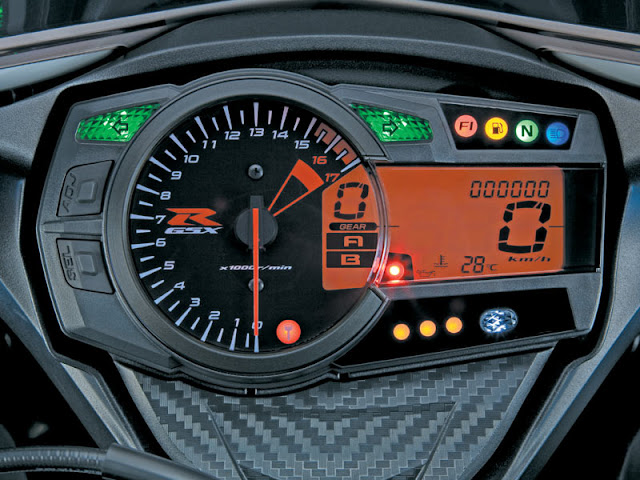Suzuki has slashed an incredible 9kg from the 2011 GSX-R600. The engine has more midrange, a close ratio gearbox and for the first time, Showa Big Piston Forks and Brembo monobloc radial front brakes. Aside from a handful of components, the GSX-R600 is completely new. The easy-going nature of the bike is still there, but it’s sharper, more agile and there’s more punch out of the corners. If only it looked a bit special and not look just like any other GSX-R to be made over the past decade.
Engine
The inline four-cylinder motor has the same basic architecture as before, with the same 599cc and 67 x 42.5mm bore and stroke. It makes around the same power, but with more midrange torque. It has new cams, pistons and pentagonal ventilation holes in the block. Compression is up and each piston assembly is 78 grams lighter. A new lighter, close-ratio gearbox has a taller first gear and shorter ratios for second, third, fourth and sixth. The final drive is changed from a 17/45 to a 16/43. A new four-into-one exhaust has stainless steel down pipes, a butterfly valve to improve low and midrange power and a titanium end can. The whole system is l.7kg lighter.
Ride and Handling
The GSX-R600 gets a new twin spar aluminium frame with more built-in flex, which is lighter, shorter and narrower around the seat area. The new swingarm is lighter too. The overall chassis set-up is typical GSX-R: pliable and friendly, but now with a tougher edge. It’s not as stiff as an R6, ZX-6R or Daytona 675, but it gives masses of feedback and you feel very comfortable pushing to your limit straight away.
For the first time the GSX-R600 is fitted with lighter-weight Showa Big Piston Forks (BPF). Unlike the old units the new forks have lots of adjustment in them for hard track riding and give a good solid feel into the corners. The harder you use them the better they are. The new brakes are a revelation too and fade very little on track.
Equipment
The GSX-R600 is as well equipped as any other supersports machine, but electronics are restricted to a two-mode power map and an electronically adjustable, speed-sensitive steering damper. The lower of the two power maps has so little power you’d barely use it and the steering damper isn’t as good as a manually-adjustable aftermarket item. Compare and buy parts for the GSX-R600 in the MCN Shop.
Quality and Reliability
It’s too early to say how the GSX-R600 will stand the test of time, but previous models aren’t quite there when it comes to durability compared to its rivals. The paint is quite thin and liable to stone chips and unless you keep it in sparkling condition, some components can lose their shine. But reliability is never in question, the cycle parts are robust and the engine unburstable.
Value
It wasn’t that long ago when a new GSX-R600 cost way less than seven grand, so today’s prices seem a lot to pay for a 600. It’s also more expensive than all of its rivals aside from the R6 and the ABS version of the CBR600RR.
Engine
The inline four-cylinder motor has the same basic architecture as before, with the same 599cc and 67 x 42.5mm bore and stroke. It makes around the same power, but with more midrange torque. It has new cams, pistons and pentagonal ventilation holes in the block. Compression is up and each piston assembly is 78 grams lighter. A new lighter, close-ratio gearbox has a taller first gear and shorter ratios for second, third, fourth and sixth. The final drive is changed from a 17/45 to a 16/43. A new four-into-one exhaust has stainless steel down pipes, a butterfly valve to improve low and midrange power and a titanium end can. The whole system is l.7kg lighter.
Ride and Handling
The GSX-R600 gets a new twin spar aluminium frame with more built-in flex, which is lighter, shorter and narrower around the seat area. The new swingarm is lighter too. The overall chassis set-up is typical GSX-R: pliable and friendly, but now with a tougher edge. It’s not as stiff as an R6, ZX-6R or Daytona 675, but it gives masses of feedback and you feel very comfortable pushing to your limit straight away.
For the first time the GSX-R600 is fitted with lighter-weight Showa Big Piston Forks (BPF). Unlike the old units the new forks have lots of adjustment in them for hard track riding and give a good solid feel into the corners. The harder you use them the better they are. The new brakes are a revelation too and fade very little on track.
Equipment
The GSX-R600 is as well equipped as any other supersports machine, but electronics are restricted to a two-mode power map and an electronically adjustable, speed-sensitive steering damper. The lower of the two power maps has so little power you’d barely use it and the steering damper isn’t as good as a manually-adjustable aftermarket item. Compare and buy parts for the GSX-R600 in the MCN Shop.
Quality and Reliability
It’s too early to say how the GSX-R600 will stand the test of time, but previous models aren’t quite there when it comes to durability compared to its rivals. The paint is quite thin and liable to stone chips and unless you keep it in sparkling condition, some components can lose their shine. But reliability is never in question, the cycle parts are robust and the engine unburstable.
Value
It wasn’t that long ago when a new GSX-R600 cost way less than seven grand, so today’s prices seem a lot to pay for a 600. It’s also more expensive than all of its rivals aside from the R6 and the ABS version of the CBR600RR.





